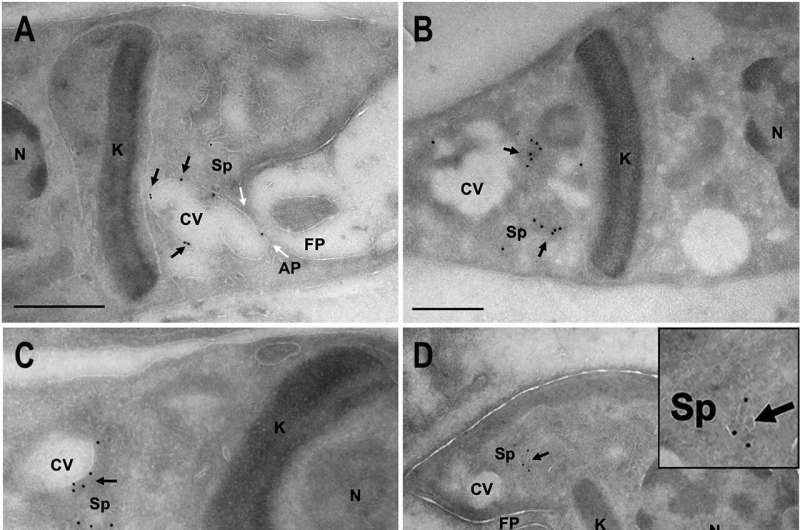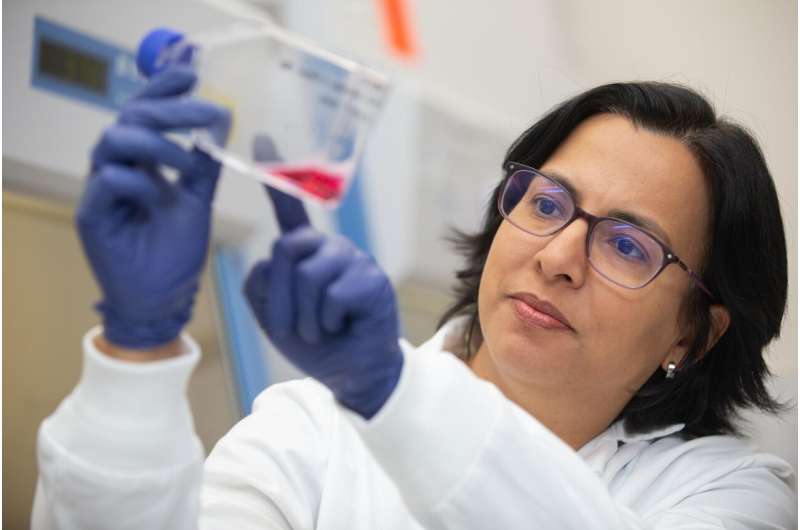This article has been reviewed according to Science X's editorial process and policies. Editors have highlighted the following attributes while ensuring the content's credibility:
fact-checked
peer-reviewed publication
trusted source
proofread
Researchers target lifecycle of parasite behind Chagas disease

Almost everything about insects called kissing bugs is revolting, from the insidious way they bite people's faces at night to drink their blood while they sleep to the way they spread disease through their poop.
Some carry a parasite called Trypanosoma cruzi that causes Chagas disease, a leading cause of disability and premature death in the Americas. Left untreated, Chagas disease can cause serious heart and digestive problems. It's showing up more and more in patients in the United States.
Now researchers at the University of Cincinnati are investigating what makes the parasite so resilient.
UC researchers are studying the signaling pathway that leads the parasite to transform and reproduce. They follow that pathway from the beginning when an uninfected kissing bug acquires the parasite by biting an infected mammal host, all the way to the time the parasite develops in the insect's gut to be spread to people or animals through the bug's poop.
The study was published in the journal mBio.
"The best way of treating the disease is understanding the biology of the parasite so we can find better drugs to kill the parasite before it's too late for the patient," said Noelia Lander, an assistant professor of biological sciences in UC's College of Arts and Sciences.

In her molecular parasitology lab at UC, Lander and her research team examined the ways T. cruzi survives in different hostile environments. They deployed technology such as the gene-editing tool CRISPR/Cas9, immunofluorescence analysis and electron microscopy for the study.
"During its lifecycle, the parasite encounters changes in acidity, temperature, nutrient availability and other conditions. It needs to survive somehow. So what we studied is how the parasite senses those microenvironmental changes and triggers reactions to transform," Lander said.
Researchers found that certain proteins play important roles in different developmental stages of the parasite. Among their functions, they help the parasite recover cell volume in the hyperosmotic environment of bug poop.
They also discovered two regions within the cell where an important "messenger molecule" called cyclic adenosine monophosphate, or cAMP, is responsible for the parasite's life cycle transformations in response to environmental stress.
"The idea is to better understand the biology of this parasite to find out which proteins in the cell are good targets for drug treatment," she said. "If we can prevent the parasite from transforming, we can kill it and also stop the transmission of disease."
The stakes are high, she said.
"The disease affects as many as 8 million people in rural areas of Latin America," Lander said. "It's called a 'silent disease.' Most people who are infected by it don't know."
But years or even decades later, Chagas disease can cause debilitating heart disease, lead author and UC Research Associate Miguel Chiurillo said.
"It's a chronic disease that mainly affects poor people in these countries with no access to treatment," Chiurillo said.
Kissing bugs are often found in older or poorly constructed homes. Sometimes they live in thatched roofs.
"Our research is mainly trying to discover new drug targets in the parasite and validate them to develop alternative strategies to control the disease," Chiurillo said.
Co-author and graduate student Joshua Carlson said too few people in the United States are aware of Chagas disease.
"A lot of people have never heard of it," Carlson said. "But hundreds of thousands of people in the United States have it. So getting educated about what the disease is and how it can be transmitted is important, especially if you plan to travel to countries where it's endemic."
University of Georgia researcher Mayara Bertolini and UC graduate Aqsa Raja also contributed to the study.
More information: Miguel A. Chiurillo et al, Dual localization of receptor-type adenylate cyclases and cAMP response protein 3 unveils the presence of two putative signaling microdomains in Trypanosoma cruzi, mBio (2023). DOI: 10.1128/mbio.01064-23
Journal information: mBio
Provided by University of Cincinnati



















